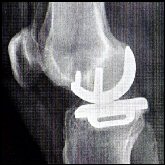VERBATIM by a very special correspondent, Mark T. Wayne,
as told to John Jonelis
 Did you know that, out of the multitudes of people that undergo knee surgery, 7% go bad within a year?* .No, I don’t mean to imply that patients with new knees turn to a life of crime, though some may do so. There are no numbers whatsoever to prove otherwise. There’s nothing to stop a man once he can run from the scene of the dastardly deed for the first time in years on his spanking new knees. The temptation must prove strong among some folks.
Did you know that, out of the multitudes of people that undergo knee surgery, 7% go bad within a year?* .No, I don’t mean to imply that patients with new knees turn to a life of crime, though some may do so. There are no numbers whatsoever to prove otherwise. There’s nothing to stop a man once he can run from the scene of the dastardly deed for the first time in years on his spanking new knees. The temptation must prove strong among some folks.  Think of it. After showing your navy revolver to the teller and receiving your withdrawal, you gleefully sprint—sprint mind you—to the bank exit and the getaway vehicle. It warms my blood to think of all the good done by rehabilitating criminals in this way—allowing a man to follow his true dreams. But I stray from the point.
Think of it. After showing your navy revolver to the teller and receiving your withdrawal, you gleefully sprint—sprint mind you—to the bank exit and the getaway vehicle. It warms my blood to think of all the good done by rehabilitating criminals in this way—allowing a man to follow his true dreams. But I stray from the point.
Saving 100,000 Knees
I mean to talk about surgeries with bad medical outcomes. Legs that won’t bend. Legs that don’t straighten out. Pain that doesn’t go away. Horrible stuff. And that’s after going through the terrible ordeal of surgery and recovery! That drives a man mad.
Let’s talk about how we can put a stop to that problem. Let’s talk about ways we can save a hundred thousand good people every year.
Most knee replacements turn out spectacularly well nowadays and it’s a miracle that so many poor cripples can walk again. But to my way of thinking, 7% failure ain’t acceptable. Why do you suppose it happens?
Would you believe it? These bad outcomes almost always stem from the simplest of all causes. People don’t talk to each other! Here’s what’s really going on:
.
The Doctor Visit
The world is moving so much faster than it did a hundred years back. Long ago, doctors visited people in their homes like gentlemen. You paid with a live chicken or a good dinner, maybe.
No more! The situation has degenerated such that it is utterly execrable. Such a momentous decision, and today is your first and only consultation with the surgeon.
Nowadays you bring along your life savings in the form of a plastic card and wait at the good doctor’s leisure in a parlor crowded with the sick and infirmed. After an hour or so of whiling away the afternoon so pleasantly, you are curtly summoned by your last name.
You are led to a small chamber. The door shuts ominously, leaving you alone with your thoughts in a room arrayed with mysterious implements that suggest the application of pain. A strange narrow bed, high as a table, dominates the room and a white runner graces its top as if Thanksgiving Dinner is to be served—with you as the main course.
And indeed, you came here to get carved like a turkey. You want a new knee and you’re desperate enough to go under the knife to get it. So you are left to stew in this hellhole long enough to soften any resolve you may otherwise muster.
Your head snaps back as this demigod, tricked out in a white lab coat, bursts through the door with a rush that puts a crick in your neck. Nowadays, a doctor’s time is more valuable than yours and in a more important way.** . If you can squeeze out more than five minutes of conversation from this highly paid meat cutter, you go home believing you got your money’s worth.
Even the nurse barely utters more than a cursory salutation as she points you to the exit. Her primary function is to prevent you from wasting the demigod’s time.
Perhaps you are graced to receive a heavy pile of printed material too massive and confusing to be of any real use. The doctors don’t read it either. Nobody reads such slop. But they don’t hesitate to add to the pile whenever they feel it necessary.
[There are those who say that I am inclined to exaggerate. Some say that my middle initial “T” stands for Trouble. I cannot endorse such sentiment. Slanders on my character like these are uncalled for and utterly ridiculous. What honest and forthright man can, in all good conscience, make such an outrageous claim? Let me go on.]
The Bad Outcome
The next glimpse you get of this demigod is on the day of your surgery—moments before the anesthesiologist puts your lights out. You may not recognize the doctor and mistake him for an orderly or a nurse.
Hours later, you wake in your hospital bed. They make you stand erect almost immediately. A brave man would scream with agony but they thought of that. They pumped you so full of morphine that you can’t feel your toes. Whiskey does not answer. It ain’t strong enough. By the next afternoon, you’re climbing a small set of artificial stairs, blissfully unaware of any pain. They do this for good reason. The sooner and more strenuously you move, the less scar tissue can form.
Naturally the demigod discharges you from the hospital a day ahead of schedule, ostensibly because you are doing so well. The real reason is to get you the hell out of there—to get you out before you contract one of the dread superbugs that plague these institutions.
Then the real fun begins. Physical therapy. Weeks and weeks of it. And your days are full from sun-up till dark. It’s such a pleasant vacation from the toils of your job. I recommend it for those of you addicted to extreme sports and for those who love to indulge in a good long binge. Under the influence of pain killers, you float through the work as if in a dream. You’re determined to do everything listed in the ten pounds of printed matter—even if you can’t focus your eyes on the letters. So you cut corners here and there. You do just a little less than is called for. Then less again. Then sleep overtakes you. Maybe you take a day or two off. Maybe you stop doing your therapy altogether.
You might not see the surgeon again for as much as six whole weeks. When you do, he looks over a hasty X-ray, shakes his head, clucks his tongue, and assesses your attitude with squinting eyes to determine if you’re likely to sue because your recovery is not going well.
 Of course your troubles aren’t the surgeon’s fault. Six weeks ago he installed the spare parts in a workmanlike manner using all his knowledge and skill, just like a good mechanic is expected to do. No, the finger points directly at you. You are responsible to follow orders during the crucial first few weeks. If only you had done such-and-such on a regular basis, all would have been well.
Of course your troubles aren’t the surgeon’s fault. Six weeks ago he installed the spare parts in a workmanlike manner using all his knowledge and skill, just like a good mechanic is expected to do. No, the finger points directly at you. You are responsible to follow orders during the crucial first few weeks. If only you had done such-and-such on a regular basis, all would have been well.
And perhaps you genuinely tried to read and comprehend those hundreds of pages of medical and legal jargon. But in all the tomes of print you somehow missed the one important exercise that—had you performed it religiously—would have resulted in a life without pain. Now it’s too late.
~~~
Ah, but I will permit you to begin anew:
~~~
The Good Outcome
Imagine now that you are considering a knee replacement for the first time. You don’t know where to begin and it all seems so complicated. But YOU have a secret weapon from a company called Wellbe.me. It’s called the Patient Guidance System™. They also call her by her initials, PGS. I call her Peggy Sue. She’s a world apart from some miserable tome of printed matter. She’s always at your elbow, ready to do your bidding. She explains every step of the way and amazingly—answers your questions just as they arise.
You never fear getting lost. You always know what to do next. You always know whether your condition is on track or you need remediation.
And she delivers messages to and from your doctor and everybody else involved in your case. She leads you from the first moment of decision to the final result—YOU CAN WALK AGAIN! They call this the “Total Episode of Care.”
Who is this Peggy Sue? This is the 21st Century sir! She’s technology! You access PGS through an easy-to-use internet site. It’s both interactive and intuitive but it won’t serve you a whiskey and soda. Use your computer, your tablet or smartphone, right from the comfort of your bed. You log what actually goes on, and you get back answers and action items.
Your surgeon, your personal doctor, your in-home nurse, your therapist, the lab that analyzes your blood, even a trusted family member—they all get alerts on your progress at just the right time. And they communicate with each other. And they communicate with you. This is as neat as a perfect spider web in the morning dew. One vibration and everybody knows exactly what’s going on.
- Maybe you alert your doctor that your pain level is still at six and you can’t
 perform the exercises. He changes your medication and flashes the prescription to your pharmacy. Problem solved. Quickly. Just a few strokes on the touch screen.
perform the exercises. He changes your medication and flashes the prescription to your pharmacy. Problem solved. Quickly. Just a few strokes on the touch screen.
- Your nurse takes a blood sample and flashes it to the lab. The lab flashes the results to your MD who relays the order to decrease your dose of blood thinner. You see the alert on your screen. Problem solved.
- The therapist visits and logs your progress. The surgeon monitors that data and schedules an early appointment because your knee is only at 80 degrees.
 He expects 90 by now and needs to evaluate your case. There’s still time—still time to do something about it. No more nonsense or finger-pointing. No more: “If only you’d done such-and-such, but now it’s too late.”
He expects 90 by now and needs to evaluate your case. There’s still time—still time to do something about it. No more nonsense or finger-pointing. No more: “If only you’d done such-and-such, but now it’s too late.”
- Nowadays, people want to be able to contact the doctor electronically. With the Patient Guidance System™, you can do that. You’re always in the loop. Peggy Sue always gives you, your doctor, and your care team a fresh report on your progress with benchmarks and checklists. No uncertainty. No confusion. No fear.
.
Better than Government Work
You figure you’ve heard all about this already. You imagine it’s the Portable Healthcare Act, right? Wrong! That law does not answer. There are too many different office systems that can’t talk to each other yet—and maybe they never will. Put all thoughts of that nightmare aside. It’s just another bureaucratic mess that seems to happen from time to time in places where politicians gather.
But this ain’t the government, sir! This is private enterprise! This is new. And this is real. This solution is simple and direct.
It’s easy to use—Everybody can access it with the same equipment they already own. Everything gets done on the cloud, so there’s no software to install. Doctors, surgeons, therapists, labs, nurses, family, and especially you can use it with whatever internet-ready hoozitz at hand—even your infernal smartphone.
The technology exists right now—This is a highly sophisticated proprietary expert system. But it’s tied to a user-friendly web interface that anybody can work.
Now why do you suppose the government didn’t think of that?
.
James Dias and Abraham Palmbach founded this startup and call it Wellbe.me. They’re out to save 100,000 patients a year. I’m glad I came out to BNC Venture Capital to see it. Maybe it will save you or me one day.
.
Footnotes
* 6.9% of knee patients experience poor results after one year, either because of stiffness or pain, according to David A. Fisher, MD, et.al. in The Journal of Arthoplasty, September 2007. http://www.sciencedirect.com/science/article/pii/S0883540307002343
.
** From Stephen Potter in his masterful book One-Upmanship, 1952.
.
Contacts
800-960-4118
.
http://www.bnchicago.org/Groups.php?group=8
.
.
Graphics and Photography courtesy Wellbe.me.
.
EDITOR’S NOTE: Mr. Wayne is known to take off on flights of fancy and exaggeration. No doubt you’ve read some of his works of fiction. Be sure to thoroughly check every one of his claims.
.
GO TO PART 3 – THE STORY BEHIND BIG DATA
.
Chicago Venture Magazine is a publication of Nathaniel Press www.ChicagoVentureMagazine.com Comments and re-posts in full or in part are welcomed and encouraged if accompanied by attribution and a web link . This is not investment advice. We do not guarantee accuracy. It’s not our fault if you lose money.
.Copyright © 2013 John Jonelis – All Rights Reserved
.
.

















































































































































































